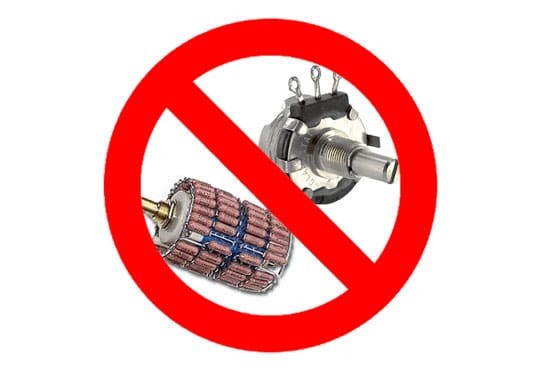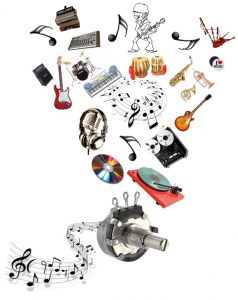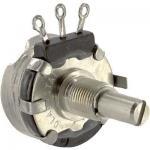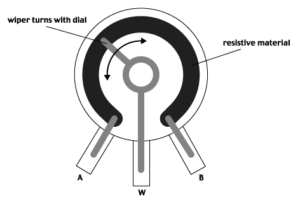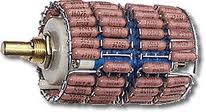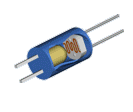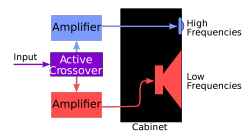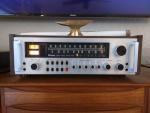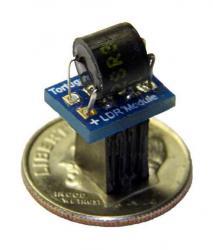What’s Wrong With Audio Volume Control?
What Is Volume Control?
Whether you own $10k+ of high end gear or a humble $200 receiver from Best Buy, chances are about 100% that every note of recorded music played through your system is funneled through a volume control device (a.k.a. an attenuator) before it reaches your ears.
In the analog signal world volume control means throttling back the voltage level of the audio signal prior to reaching your amplifier. That’s how volume is controlled; by reducing the signal voltage using a voltage divider.
When you stop and think about it reducing voltage (i.e. volume) means you are squeezing all that energy through a type of electronic funnel. In fact you are quite literally dumping (shunting) some of that energy into the ground.
In reality volume control is quite unkind to the audio signal and so no surprise that the device you choose for your volume control matters. How much? Quite as bit in fact.
The Potentiometer
Most volume control is done with a potentiometer – a “pot”. If you work closely with the design of audio equipment, you soon discover the negative impact that a pot can have on audio quality. In most cases, it’s not even subtle. Why is that?
Pots are essentially mechanical devices. As you turn a pot, a lightweight internal wiper slides across some type of stationary resistive material. “Funny things” happen at this very small mechanical interface point that degrades the audio signal.
And then there’s the resistive material itself. Back in the day, most pots were made of graphite; a form of conductive carbon. Even with today’s high grade audio pots the signal has to pass through carbon impregnated conductive polymers. While better than the old school graphite pots, modern pots are still far from an ideal signal conductor. Simply put, carbon isn’t all that great a material to shove music through. Yes, it gets the job done of volume control but not without leaving its own footprint on the audio.
Pots also have issues with signal crossover between left and right channels and also matching the resistance curves of each channel within a two channel stereo pot.
Many audio enthusiasts abandon pots for the next best thing – a stepped attenuator.
The Stepped Attenuator
A stepped attenuator is geeky audio term for a complex multi-pole mechanical switch with a ton of resistors attached. It uses a big rotary switch to select discrete resistor pairs usually corresponding to a few dB change in volume per step. But it’s still a mechanical device with multiple metal-on-metal contact points that can wear and corrode as well as introduce their own source of noise.
These are relatively large mechanical devices with dozens of contacts that take a fair amount of torque to turn. With rare exception they must be adjusted manually. You can forget picking up a remote to tweak or mute your volume. Get up and do it by hand! As an audio enthusiast fond of his listening chair, this is where I personally draw the line. Gotta have a remote.
Stepped attenuators have a key advantage over pots in that they allow the use of friendlier resistive materials such a metal film resistors. While better than pots, the audio is still being throttled by resistive materials that are far from ideal conductors of music.
The Transformer Volume Control
Transformer volume controllers (“TVC’s”) are arguably a step up from stepped attenuators – pardon the pun. TVCs abandon resistive materials altogether and use transformers to convey (and throttle) the audio signal electromagnetically.
Conceptually similar to a stepped resistive attenuator, a stepped transformer uses a primary input winding together with 20 or more logarithmic secondary windings corresponding to some dB level of change per winding. These are highly customized transformers and are typically hand wound with exotic materials and quite costly. At least one is required per channel. Add a pair of rotary mechanical switches and you have yourself the ultimate non-resistive volume control.
Most TVCs are very expensive and utilize complex manually operated multi-contact mechanical switches. And again, no remote. Do they sound great? Some think so. Others complain of a certain veiled effect
However, there is an even better alternative.
The Light Dependent Resistor
The light dependent resistor – or LDR – is yet another type of resistive volume control device. Unlike mechanical or electro-magnetic volume controllers, the LDR is an electro-optical device that uses light to change resistance. An LDR combines two different analog devices encapsulated into a small cylindrical part about the size of a piece of M&M candy. On one end there is a light emitting diode – the LED. On the other end is a photoresistor.
LDRs work by regulating the light intensity of the the LED which in turn changes the resistance of the photoresistor. The greater the light, the lower the resistance. Thus light and resistance are optically coupled. LDRs are often referred to as “optocouplers”.
The key difference between LDRs and all other conventional resistive volume control devices is the nature of the resistive material itself. The variable resistor material in LDRs is actually a type of specialized thin-film semiconductor material that is incredibly friendly towards audio signals.
Typical adjectives applied to LDRs include: articulate, clean, open, transparent, uncolored, unveiled, and dynamic. They have a flat frequency response, convey incredible bass, wide open mid range, and amazing highs.
LDRs are, without equivocation, ideal conductors of music!
That’s the good news. The bad news, at least for audio designers, is that LDRs are very challenging to work with. LDRs are highly nonlinear and highly variable from one to the next. Traditionally, designers had to sort through 100’s of LDRs to find sets having matched performance curves.
Tortuga Audio overcame these challenges and moved beyond using matched sets of LDRs by incorporating LDR calibration directly into the design of the attenuator. Plug in a set of LDRs, run calibration, and the LDRs are automatically calibrated to work together regardless of their differences. We are currently on our 4th iteration of LDR technology with the V4 Preamp Controller. Our LDR based passive preamps represent an incredible value in high performance audio compared to practically all other options regardless of price.
We invite you to try out our LDR based passivLDR based passive preamp components and decide for yourself. We offer a 30 day buy-try-decide in home audition policy with 100% refund if you’re not happy with your new preamp. You’ve got nothing to lose!
